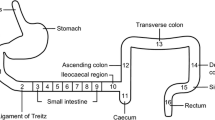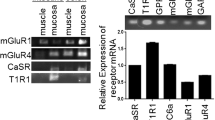Abstract
Glucagon-like peptide 1 (GLP-1) is a multifunctional hormone in glucose metabolism and intestinal function released by enteroendocrine L-cells. The plasma concentration of GLP-1 is increased by indigestible carbohydrates and luminal infusion of short-chain fatty acids (SCFAs). However, the triggers and modulators of the GLP-1 release remain unclear. We hypothesized that SCFAs produced by bacterial fermentation are involved in enteroendocrine cell proliferation and hormone release through free fatty acid receptor 2 (FFA2, also known as FFAR2 or GPR43) in the large intestine. Fructo-oligosaccharide (Fructo-OS), fermentable indigestible carbohydrate, was used as a source of SCFAs. Rats were fed an indigestible-carbohydrate-free diet (control) or a 5% Fructo-OS-containing diet for 28 days. FFA2-, GLP-1-, and 5-hydroxytryptamine (5-HT)-positive enteroendocrine cells were quantified immunohistochemically in the colon, cecum, and terminal ileum. The same analysis was performed in surgical specimens from human lower intestine. The coexpression of FFA2 with GLP-1 was investigated both in rats and humans. Fructo-OS supplementation in rats increased the densities of FFA2-positive enteroendocrine cells in rat proximal colon, by over two-fold, relative to control, in parallel with GLP-1-containing L-cells. The segmental distributions of these cells in human were similar to rats fed the control diet. The FFA2-positive enteroendocrine cells were GLP-1-containing L-cells, but not 5-HT-containing EC cells, in both human and rat colon and terminal ileum. Fermentable indigestible carbohydrate increases the number of FFA2-positive L-cells in the proximal colon. FFA2 activation by SCFAs might be an important trigger for produce and release GLP-1 by enteroendocrine L-cells in the lower intestine.





Similar content being viewed by others
References
Amato A, Cinci L, Rotondo A, Serio R, Faussone Pellegrini MS, Vannucchi MG, Mule F (2010) Peripheral motor action of glucagon-like peptide-1 through enteric neuronal receptors. Neurogastroenterol Motil 22:e203–e664
Bottcher G, Alumets J, Hakanson R, Sundler F (1986) Co-existence of glicentin and peptide YY in colorectal L-cells in cat and man. An electron microscopic study. Regul Pept 13:283–291
Breuer RI, Buto SK, Christ ML, Bean J, Vernia P, Paoluzi P, Di Paolo MC, Caprilli R (1991) Rectal irrigation with short-chain fatty acids for distal ulcerative colitis. Preliminary report. Dig Dis Sci 36:185–187
Brown AJ, Goldsworthy SM, Barnes AA, Eilert MM, Tcheang L, Daniels D, Muir AI, Wigglesworth MJ, Kinghorn I, Fraser NJ, Pike NB, Strum JC, Steplewski KM, Murdock PR, Holder JC, Marshall FH, Szekeres PG, Wilson S, Ignar DM, Foord SM, Wise A, Dowell SJ (2003) The Orphan G protein-coupled receptors GPR41 and GPR43 are activated by propionate and other short chain carboxylic acids. J Biol Chem 278:11312–11319
Campbell JM, Fahey GC Jr, Wolf BW (1997) Selected indigestible oligosaccharides affect large bowel mass, cecal and fecal short-chain fatty acids, pH and microflora in rats. J Nutr 127:130–136
Cani PD, Dewever C, Delzenne NM (2004) Inulin-type fructans modulate gastrointestinal peptides involved in appetite regulation (glucagon-like peptide-1 and ghrelin) in rats. Br J Nutr 92:521–526
Cani PD, Knauf C, Iglesias MA, Drucker DJ, Delzenne NM, Burcelin R (2006) Improvement of glucose tolerance and hepatic insulin sensitivity by oligofructose requires a functional glucagon-like peptide 1 receptor. Diabetes 55:1484–1490
Cani PD, Hoste S, Guiot Y, Delzenne NM (2007) Dietary non-digestible carbohydrates promote L-cell differentiation in the proximal colon of rats. Br J Nutr 98:32–37
Cummings JH (1981) Short chain fatty acids in the human colon. Gut 22:763–779
Deacon CF, Pridal L, Klarskov L, Olesen M, Holst JJ (1996) Glucagon-like peptide 1 undergoes differential tissue-specific metabolism in the anesthetized pig. Am J Physiol 271:E458–E464
Dumoulin V, Moro F, Barcelo A, Dakka T, Cuber JC (1998) Peptide YY, glucagon-like peptide-1, and neurotensin responses to luminal factors in the isolated vascularly perfused rat ileum. Endocrinology 139:3780–3786
Eissele R, Goke R, Willemer S, Harthus HP, Vermeer H, Arnold R, Goke B (1992) Glucagon-like peptide-1 cells in the gastrointestinal tract and pancreas of rat, pig and man. Eur J Clin Invest 22:283–291
Freeland KR, Wolever TM (2010) Acute effects of intravenous and rectal acetate on glucagon-like peptide-1, peptide YY, ghrelin, adiponectin and tumour necrosis factor-alpha. Br J Nutr 103:460–466
Gee JM, Johnson IT (2005) Dietary lactitol fermentation increases circulating peptide YY and glucagon-like peptide-1 in rats and humans. Nutrition 21:1036–1043
Giralt M, Vergara P (1998) Sympathetic pathways mediate GLP-1 actions in the gastrointestinal tract of the rat. Regul Pept 74:19–25
Hansen L, Deacon CF, Orskov C, Holst JJ (1999) Glucagon-like peptide-1-(7–36)amide is transformed to glucagon-like peptide-1-(9–36)amide by dipeptidyl peptidase IV in the capillaries supplying the L cells of the porcine intestine. Endocrinology 140:5356–5363
Holst JJ, Gromada J (2004) Role of incretin hormones in the regulation of insulin secretion in diabetic and nondiabetic humans. Am J Physiol Endocrinol Metab 287:E199–E206
Hubel KA, Russ L (1933) Mechanisms of the secretory response to luminal propionate in rat descending colon in vitro. J Auton Nerv Syst 43:219–229
Imeryuz N, Yegen BC, Bozkurt A, Coskun T, Villanueva Penacarrillo ML, Ulusoy NB (1997) Glucagon-like peptide-1 inhibits gastric emptying via vagal afferent-mediated central mechanisms. Am J Physiol 273:G920–G927
Kaji I, Karaki S-I, Tanaka R, Kuwahara A (2010) Fructo-oligosaccharide (FOS) supplementation increases enteroendocrine L cells containing GLP-1 and SCFA receptor GPR43 (FFA2) in the large intestine. Gastroenterology 138:S-405
Karaki S, Mitsui R, Hayashi H, Kato I, Sugiya H, Iwanaga T, Furness JB, Kuwahara A (2006) Short-chain fatty acid receptor, GPR43, is expressed by enteroendocrine cells and mucosal mast cells in rat intestine. Cell Tissue Res 324:353–360
Karaki S, Tazoe H, Hayashi H, Kashiwabara H, Tooyama K, Suzuki Y, Kuwahara A (2008) Expression of the short-chain fatty acid receptor, GPR43, in the human colon. J Mol Histol 39:135–142
Le Poul E, Loison C, Struyf S, Springael JY, Lannoy V, Decobecq ME, Brezillon S, Dupriez V, Vassart G, Van Damme J, Parmentier M, Detheux M (2003) Functional characterization of human receptors for short chain fatty acids and their role in polymorphonuclear cell activation. J Biol Chem 278:25481–25489
Lindsay JO, Whelan K, Stagg AJ, Gobin P, Al Hassi HO, Rayment N, Kamm MA, Knight SC, Forbes A (2006) Clinical, microbiological, and immunological effects of fructo-oligosaccharide in patients with Crohn’s disease. Gut 55:348–355
Mitsui R, Ono S, Karaki S, Kuwahara A (2005a) Neural and non-neural mediation of propionate-induced contractile responses in the rat distal colon. Neurogastroenterol Motil 17:585–594
Mitsui R, Ono S, Karaki S, Kuwahara A (2005b) Propionate modulates spontaneous contractions via enteric nerves and prostaglandin release in the rat distal colon. Jpn J Physiol 55:331–338
Mitsui R, Karaki SI, Kubo Y, Sugiura Y, Kuwahara A (2006) Fibre-free diet leads to impairment of neuronally mediated muscle contractile response in rat distal colon. Neurogastroenterol Motil 18:1093–1101
Mojsov S, Heinrich G, Wilson IB, Ravazzola M, Orci L, Habener JF (1986) Preproglucagon gene expression in pancreas and intestine diversifies at the level of post-translational processing. J Biol Chem 261:11880–11889
Naslund E, Bogefors J, Skogar S, Gryback P, Jacobsson H, Holst JJ, Hellstrom PM (1999) GLP-1 slows solid gastric emptying and inhibits insulin, glucagon, and PYY release in humans. Am J Physiol 277:R910–R916
Nilsson NE, Kotarsky K, Owman C, Olde B (2003) Identification of a free fatty acid receptor, FFA2R, expressed on leukocytes and activated by short-chain fatty acids. Biochem Biophys Res Commun 303:1047–1052
Orskov C, Holst JJ, Nielsen OV (1988) Effect of truncated glucagon-like peptide-1 [proglucagon-(78–107) amide] on endocrine secretion from pig pancreas, antrum, and nonantral stomach. Endocrinology 123:2009–2013
Savage DC (1986) Gastrointestinal microflora in mammalian nutrition. Annu Rev Nutr 6:155–178
Scheppach W, Sommer H, Kirchner T, Paganelli GM, Bartram P, Christl S, Richter F, Dusel G, Kasper H (1992) Effect of butyrate enemas on the colonic mucosa in distal ulcerative colitis. Gastroenterology 103:51–56
Sjolund K, Sanden G, Hakanson R, Sundler F (1983) Endocrine cells in human intestine: an immunocytochemical study. Gastroenterology 85:1120–1130
Stoddart LA, Smith NJ, Milligan G (2008) International union of pharmacology. LXXI. Free fatty acid receptors FFA1, -2, and -3: pharmacology and pathophysiological functions. Pharmacol Rev 60:405–417
Ten Bruggencate SJ, Bovee Oudenhoven IM, Lettink Wissink ML, Van der Meer R (2005) Dietary fructooligosaccharides increase intestinal permeability in rats. J Nutr 135:837–842
Vilsboll T, Krarup T, Sonne J, Madsbad S, Volund A, Juul AG, Holst JJ (2003) Incretin secretion in relation to meal size and body weight in healthy subjects and people with type 1 and type 2 diabetes mellitus. J Clin Endocrinol Metab 88:2706–2713
Wettergren A, Schjoldager B, Mortensen PE, Myhre J, Christiansen J, Holst JJ (1993) Truncated GLP-1 (proglucagon 78–107-amide) inhibits gastric and pancreatic functions in man. Dig Dis Sci 38:665–673
Yajima T (1985) Contractile effect of short-chain fatty acids on the isolated colon of the rat. J Physiol 368:667–678
Yajima T (1988) Luminal propionate-induced secretory response in the rat distal colon in vitro. J Physiol 403:559–575
Yusta B, Huang L, Munroe D, Wolff G, Fantaske R, Sharma S, Demchyshyn L, Asa SL, Drucker DJ (2000) Enteroendocrine localization of GLP-2 receptor expression in humans and rodents. Gastroenterology 119:744–755
Acknowledgments
We thank Dr. John B Furness (University of Melbourne) for advices to the manuscript. Meiji Seika Kaisha, Ltd is thanked for obtaining Fructo-OS and analyzing its components. This work was supported in part by funding from the Japan Society for the Promotion of Science (no. 21590235).
Author information
Authors and Affiliations
Corresponding author
Rights and permissions
About this article
Cite this article
Kaji, I., Karaki, Si., Tanaka, R. et al. Density distribution of free fatty acid receptor 2 (FFA2)-expressing and GLP-1-producing enteroendocrine L cells in human and rat lower intestine, and increased cell numbers after ingestion of fructo-oligosaccharide. J Mol Hist 42, 27–38 (2011). https://doi.org/10.1007/s10735-010-9304-4
Received:
Accepted:
Published:
Issue Date:
DOI: https://doi.org/10.1007/s10735-010-9304-4




